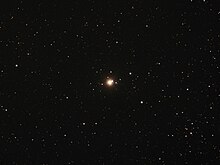Eta Persei
| Observation data Epoch J2000 Equinox J2000 | |
|---|---|
| Constellation | Perseus |
| Right ascension | 02h 50m 41.766s[1] |
| Declination | +55° 53′ 43.7876″[1] |
| Apparent magnitude (V) | 3.79[2] |
| Characteristics | |
| Spectral type | K3 Ib[3] |
| U−B color index | +1.90[2] |
| B−V color index | +1.69[2] |
| Astrometry | |
| Radial velocity (Rv) | −1.07 ± 0.27[4] km/s |
| Proper motion (μ) | RA: +16.574[1] mas/yr Dec.: −12.709[1] mas/yr |
| Parallax (π) | 4.2061 ± 0.3744[1] mas |
| Distance | 780 ± 70 ly (240 ± 20 pc) |
| Absolute magnitude (MV) | −4.29[5] |
| Details | |
| Radius | 134[6] R☉ |
| Luminosity | 4,130[6] L☉ |
| Temperature | 3,986±170[6] K |
| Rotational velocity (v sin i) | 5.8[3] km/s |
| Other designations | |
| Database references | |
| SIMBAD | data |
Eta Persei (η Persei, abbreviated Eta Per, η Per), is a binary star and the 'A' component of a triple star system (the 'B' component is the star )[7] in the constellation of Perseus. It is approximately 1331 light-years away from Earth.
The two components of Eta Persei itself are designated Eta Persei A (officially named Miram /ˈmaɪræm/, a recent name for the system)[8] and B.
Nomenclature[]

η Persei (Latinised to Eta Persei) is the binary star's Bayer designation. The designations of its two components as Eta Persei A and B derive from the convention used by the Washington Multiplicity Catalog (WMC) for multiple star systems, and adopted by the International Astronomical Union (IAU).[9]
Eta Persei mysteriously gained the named Miram in the 20th Century, though no source is known.[10][11] In 2016, the IAU organized a Working Group on Star Names (WGSN)[12] to catalog and standardize proper names for stars. The WGSN decided to attribute proper names to individual stars rather than entire multiple systems.[13] It approved the name Miram for the component Eta Persei A on 5 September 2017 and it is now so included in the List of IAU-approved Star Names.[8]
This star, together with Delta Persei, Psi Persei, Sigma Persei, Alpha Persei and Gamma Persei has been called the Segment of Perseus.[11]
In Chinese, 天船 (Tiān Chuán), meaning Celestial Boat, refers to an asterism consisting of Eta Persei, Gamma Persei, Alpha Persei, Psi Persei, Delta Persei, 48 Persei, Mu Persei and . Consequently, the Chinese name for Eta Persei itself is 天船一 (Tiān Chuán yī, English: the First Star of Celestial Boat.)[14]
Properties[]
Eta Persei A belongs to spectral class K3 and has an apparent magnitude of +3.76. It radiates with 35,000 times the luminosity of the Sun.[15]
References[]
- ^ a b c d e Brown, A. G. A.; et al. (Gaia collaboration) (August 2018). "Gaia Data Release 2: Summary of the contents and survey properties". Astronomy & Astrophysics. 616. A1. arXiv:1804.09365. Bibcode:2018A&A...616A...1G. doi:10.1051/0004-6361/201833051. Gaia DR2 record for this source at VizieR.
- ^ a b c Ducati, J. R. (2002). "VizieR Online Data Catalog: Catalogue of Stellar Photometry in Johnson's 11-color system". CDS/ADC Collection of Electronic Catalogues. 2237. Bibcode:2002yCat.2237....0D.
- ^ a b De Medeiros, J. R.; Udry, S.; Burki, G.; Mayor, M. (2002). "A catalog of rotational and radial velocities for evolved stars. II. Ib supergiant stars". Astronomy and Astrophysics. 395: 97–98. arXiv:1312.3474. Bibcode:2002A&A...395...97D. doi:10.1051/0004-6361:20021214.
- ^ Famaey, B.; Jorissen, A.; Luri, X.; Mayor, M.; Udry, S.; Dejonghe, H.; Turon, C. (2005). "Local kinematics of K and M giants from CORAVEL/Hipparcos/Tycho-2 data. Revisiting the concept of superclusters". Astronomy and Astrophysics. 430: 165. arXiv:astro-ph/0409579. Bibcode:2005A&A...430..165F. doi:10.1051/0004-6361:20041272. S2CID 17804304.
- ^ Ryon, Jenna; Shetrone, Matthew D.; Smith, Graeme H. (2009). "Comparing the Ca ii H and K Emission Lines in Red Giant Stars". Publications of the Astronomical Society of the Pacific. 121 (882): 842. arXiv:0907.3346. Bibcode:2009PASP..121..842R. doi:10.1086/605456. S2CID 17821279.
- ^ a b c Messineo, M.; Brown, A. G. A. (2019). "A Catalog of Known Galactic K-M Stars of Class I Candidate Red Supergiants in Gaia DR2". The Astronomical Journal. 158 (1): 20. arXiv:1905.03744. Bibcode:2019AJ....158...20M. doi:10.3847/1538-3881/ab1cbd. S2CID 148571616.
- ^ "Washington Double Star Catalog". United States Naval Observatory. Archived from the original on 14 February 2011. Retrieved 2 January 2018.
- ^ a b "Naming Stars". IAU.org. Retrieved 16 December 2017.
- ^ Hessman, F. V.; Dhillon, V. S.; Winget, D. E.; Schreiber, M. R.; Horne, K.; Marsh, T. R.; Guenther, E.; Schwope, A.; Heber, U. (2010). "On the naming convention used for multiple star systems and extrasolar planets". arXiv:1012.0707 [astro-ph.SR].
- ^ Kaler, Jim. "Eta Persei". Retrieved 2017-02-11.
- ^ a b Allen, R. H. (1963). Star Names: Their Lore and Meaning (Reprint ed.). New York: Dover Publications Inc. p. 331. ISBN 0-486-21079-0. Retrieved 2012-09-04.
- ^ "IAU Working Group on Star Names (WGSN)". Retrieved 22 May 2016.
- ^ "WG Triennial Report (2015-2018) - Star Names" (PDF). p. 5. Retrieved 2018-07-14.
- ^ (in Chinese) AEEA (Activities of Exhibition and Education in Astronomy) 天文教育資訊網 2006 年 7 月 11 日
- ^ Mallik, Sushma V. (December 1999), "Lithium abundance and mass", Astronomy and Astrophysics, 352: 495–507, Bibcode:1999A&A...352..495M
- Bayer objects
- Perseus (constellation)
- K-type supergiants
- Stars with proper names
- HR objects
- Henry Draper Catalogue objects
- Flamsteed objects
- Durchmusterung objects
- Hipparcos objects
- Double stars
